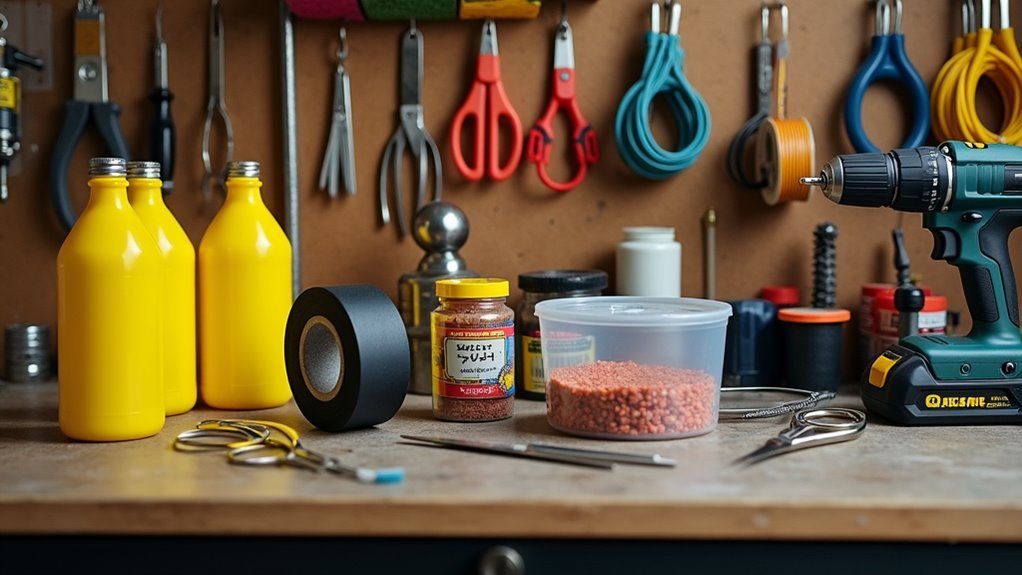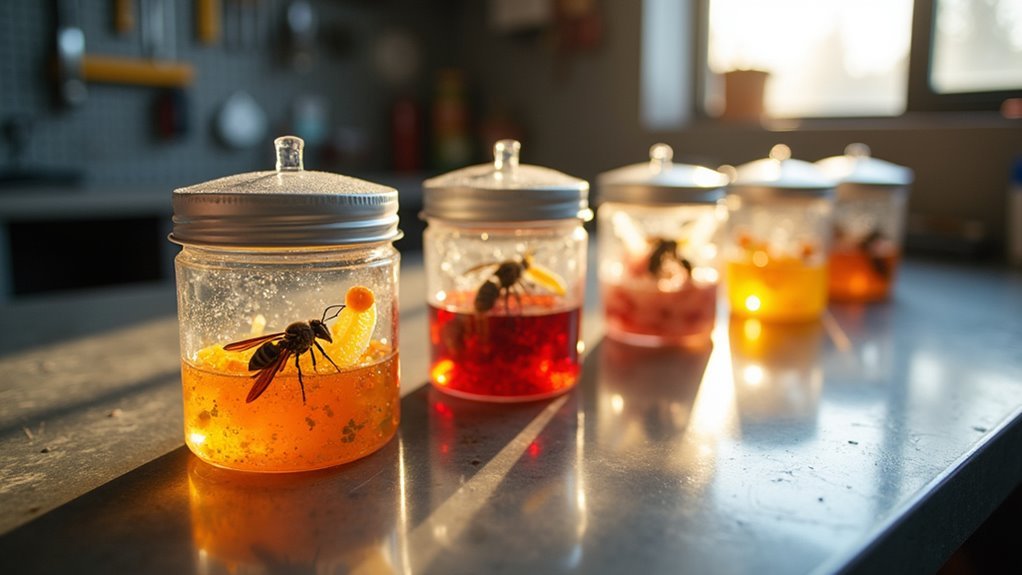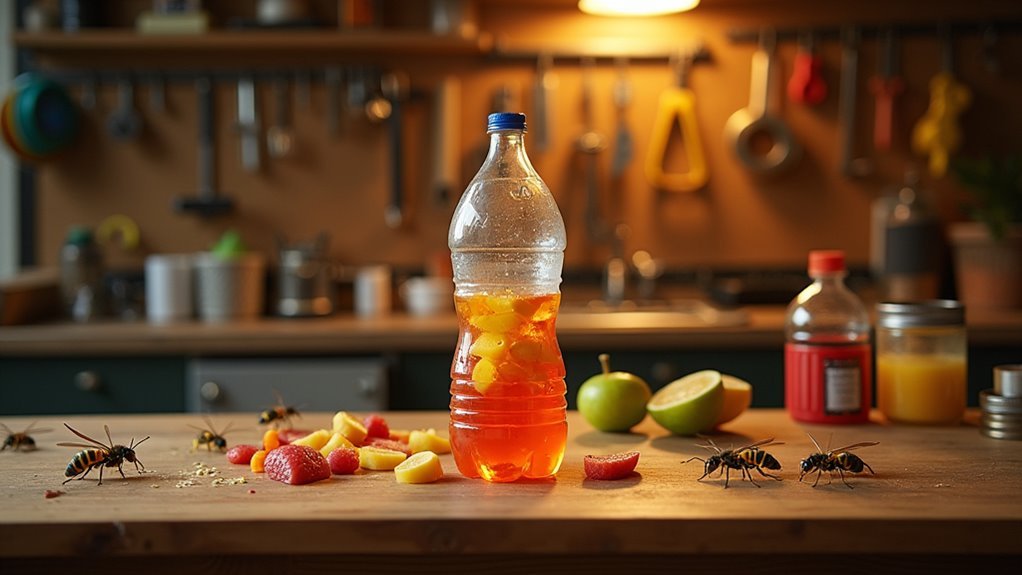You can build an effective garage wasp trap using a two-liter plastic bottle, scissors, and sweet bait like fruit juice or soda. Cut the bottle’s top off, invert it as a funnel, and secure with tape. Fill the bottom with two inches of sugar water mixed with dishwashing liquid. Place your trap 10-20 meters from living areas in a sunny spot for maximum effectiveness. Follow these strategic placement and maintenance techniques to transform your garage into a wasp-free zone.
Materials and Tools for Your DIY Garage Wasp Trap

Five simple materials will get your DIY garage wasp trap up and running effectively.
You’ll need a two-liter plastic soda bottle as your trap’s foundation. Grab scissors or a bread knife for cutting the bottle’s top section cleanly.
Sweet bait like fruit juice or soda attracts wasps into your homemade pest control device. Secure the inverted top with tape, creating an inescapable funnel design.
Fruit juice or soda works perfectly as wasp bait when paired with an inverted bottle top funnel design.
Add dishwashing liquid to your bait solution – it breaks surface tension and prevents trapped wasps from escaping. This simple addition considerably improves your trap’s efficiency.
Once you’ve assembled everything, you’ll have an effective wasp elimination system.
Regular maintenance involves removing dead wasps and revitalizing the bait to maintain ideal performance throughout the season.
Step-by-Step Assembly Instructions for Maximum Effectiveness
Now that you’ve gathered your materials, let’s walk through assembling your garage wasp trap for best results.
Start by cutting your two-liter bottle’s top off, creating a funnel that fits snugly into the bottom half. Fill the bottom with two inches of sugar water or sweet fruit juice – this bait’s highly effective for trapping wasps and yellow jacket trap success.
- Insert the inverted top as a funnel and seal edges with duct tape
- Puncture small entry holes below the funnel line for wasp access
- Position your wasp catcher 10-20 meters from living areas in sunny spots
- Check regularly if there’s a nest near your garage for ideal placement
This design proves more reliable than sticky trap alternatives, preventing painful stings while maintaining high effective capture rates.
Proven Bait Recipes That Attract Wasps Every Time

While your trap design determines capture efficiency, the bait you choose makes the difference between an empty bottle and dozens of trapped wasps. Sweet baits work exceptionally well for attracting wasps, especially yellow jackets drawn to sugary substances.
Mix jam with water or use fruit juices as your foundation. For enhanced effectiveness, combine protein baits like raw hamburger or canned tuna with sweet liquids, creating dual attraction that targets different feeding behaviors.
The most proven recipe combines sugar water with wine vinegar—wasps enter but can’t escape. Beer and sweet soda also excel as attractants.
Experiment with different bait recipes mixing proteins and sweets. Remember, these traps primarily target aggressive species like yellow jackets rather than beneficial honey bees, helping reduce wasp stings around your garage.
Strategic Placement Tips for Optimal Trap Performance
Even the most effective bait won’t deliver results if you’ve positioned your traps incorrectly.
Strategic placement determines whether your yellow jacket wasp traps actually capture these aggressive insects or simply waste your time.
Position your wasp traps in sunny locations where wasps naturally gravitate toward warmth and light.
Place them 10-20 meters from outdoor gatherings and living spaces to draw insects away from these areas.
Target zones with high wasp activity or near a known wasps nest for maximum impact.
- Install traps in bright, warm spots that receive direct sunlight throughout the day
- Keep traps away from sweet-smelling food sources that might confuse targeting
- Position near confirmed wasp nests or high-traffic wasp areas
- Monitor and replace bait regularly to maintain trap effectiveness
This strategic approach guarantees your garage wasp trap system works efficiently.
Maintenance and Safety Guidelines for Long-Term Success

Proper trap maintenance extends far beyond correct placement and determines whether your garage wasp trap system continues working effectively season after season.
You’ll need to replace sticky trap paper every few weeks to maintain high capture rates and prevent insect buildup. Clean the trap thoroughly with soap and water, removing residue that deters yellow jacket activity before reusing it.
Always handle traps carefully, wearing gloves to avoid painful stings during maintenance. Store your wasp traps in dry locations when not in use, protecting materials from damage.
Confirm ideal locations still provide adequate sunlight and remain away from human activity areas. This consistent maintenance routine guarantees long-term success while maximizing both effectiveness and safety throughout your wasp control efforts.
Frequently Asked Questions
Is There a Wasp Trap That Actually Works?
Yes, you’ll find effective wasp traps exist. Commercial options like RESCUE! TrapStik work well, but DIY bottle traps with sweet baits often perform better. You’ll need strategic placement in sunny, high-activity areas for best results.
What Is the Best Liquid to Put in a Wasp Trap?
You’ll get best results mixing sweet fruit juice or soda with jam dissolved in water. Add raw hamburger for protein attraction and a dash of wine vinegar to mimic fermenting foods wasps crave.
Why Is the Wasp Trap Not Working?
Your wasp trap isn’t working because you’re using ineffective bait, placing it too close to activity areas, neglecting maintenance, positioning it poorly, or using a trap that’s too small.
What Do Professionals Use to Get Rid of Wasps?
You’ll find professionals use specialized insecticides like microencapsulated diazinon, long-range sprays, protective gear, targeted traps, and conduct thorough inspections. They’ll also provide preventative advice to stop future infestations.
In Summary
You’ve got everything you need to eliminate wasps from your garage effectively. Follow these instructions carefully, use the proven bait recipes, and place your trap strategically for best results. Don’t forget to maintain your trap regularly and prioritize safety throughout the process. With consistent effort, you’ll notice fewer wasps invading your space. Start building your trap today and reclaim your garage from these unwanted pests once and for all.





Leave a Reply